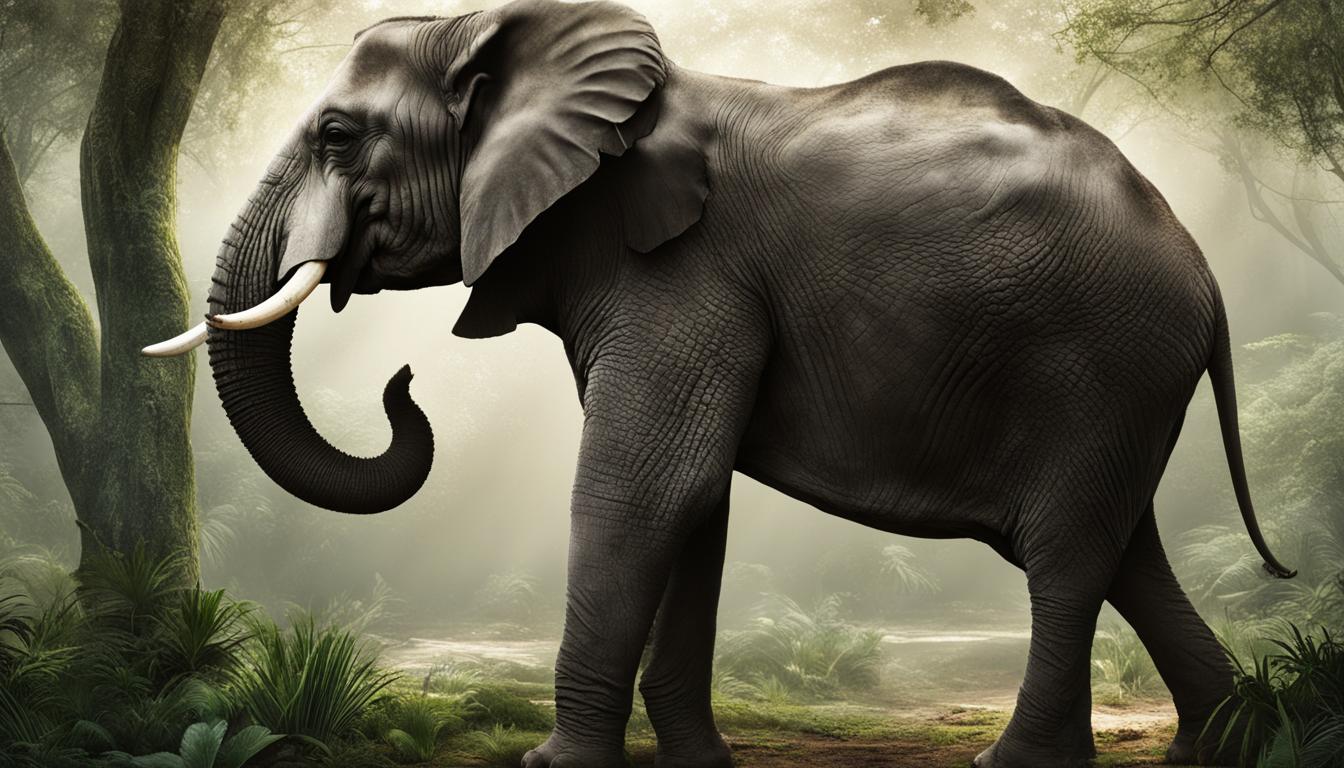Elephants are highly intelligent animals with large complex brains. They exhibit advanced cognitive abilities such as visual symbol discrimination, long-term memory, means-end recognition, tool use, and an understanding of cooperation. Despite this, previous studies have shown that elephants have struggled to demonstrate insightful problem-solving abilities. However, new research has discovered that elephants are indeed capable of using tools to solve problems. In one study, a 7-year-old male Asian elephant spontaneously used a large plastic cube as a tool to acquire food placed out of reach. He also showed behavioral flexibility by generalizing this tool utilization technique to other objects. This suggests that elephants have the capacity for insightful problem-solving.
However, it is interesting to note that the measured traits did not significantly predict learning ability. This suggests that while certain personality traits may influence problem-solving skills, they may not necessarily impact an elephant’s ability to acquire new knowledge or learn from past experiences. Further research is needed to gain a deeper understanding of the relationship between personality traits and learning ability in elephants.
By studying the influence of personality traits on problem-solving in elephants, researchers are contributing to the development of effective management strategies. These strategies can help predict which individuals are more likely to overcome obstacles or habituate to deterrents, thus aiding in elephant conservation efforts. Moreover, understanding how individual personalities impact problem-solving can also contribute to improving the welfare of captive elephants by tailoring enrichment activities and providing mental stimulation that aligns with their specific traits.
Tools and Problem-Solving in Elephant Conservation
Understanding how elephants use tools and solve problems is crucial for effective elephant conservation efforts. Elephants often face challenges in the wild, such as accessing food or avoiding conflicts with humans. By studying their problem-solving abilities and personality traits, conservation managers can develop targeted strategies to mitigate human-elephant conflict and protect both elephants and human communities.
One of the key tools in elephant conservation is understanding how certain personality traits can influence problem-solving abilities. Research has shown that traits such as aggressiveness and activity play a significant role in an elephant’s ability to overcome novel problems. By identifying individuals with these traits, conservationists can predict which elephants are more likely to find solutions and adapt to deterrents, ultimately reducing human-elephant conflict.
“If certain personality traits enable elephants to overcome these novel problems, they may be more likely to invade farmland and contribute to human-elephant conflict.”
Furthermore, studying elephant problem-solving can help identify effective conservation methods. For example, if elephants are observed using specific tools or problem-solving techniques to access food, conservation managers can design artificial feeding stations or implement deterrents that mimic these natural solutions. This proactive approach can help prevent crop damage and promote coexistence between elephants and local communities.
| Conservation Method | Description |
|---|---|
| Habituation | Gradually exposing elephants to human presence to reduce fear and aggression. |
| Electric Fences | Creating physical barriers to keep elephants away from agricultural areas. |
| Community Education | Informing local communities about elephant behavior and conservation strategies to promote coexistence. |
| Artificial Water Sources | Providing alternative water sources to minimize human-elephant contact at natural water points. |
In conclusion, understanding how elephants use tools and solve problems is essential for effective elephant conservation. By studying their problem-solving abilities, conservation managers can design targeted strategies to mitigate human-elephant conflict and protect both elephants and local communities. Additionally, identifying individuals with specific personality traits can help predict problem-solving abilities and inform the development of proactive conservation methods. By combining scientific research with proactive conservation efforts, we can ensure the long-term survival and well-being of these magnificent creatures.
Implications for Elephant Welfare
When it comes to elephant welfare, problem-solving plays a crucial role in enhancing their overall well-being. Enrichment activities that encourage elephants to utilize their problem-solving skills can provide mental stimulation and prevent boredom in captive elephants. By understanding the efficient problem-solving strategies employed by elephants, caretakers and researchers can develop innovative methods and tools to enrich the lives of these magnificent creatures.
One effective way to promote problem-solving in captive elephants is by providing them with objects or puzzles that require the use of tools. These activities not only engage their cognitive abilities but also mimic the natural foraging behaviors they would exhibit in the wild. These types of enrichment activities can help alleviate stress and improve the quality of life for captive elephants.
Moreover, supporting the development of problem-solving skills in captive elephants can also aid in their long-term welfare. Elephants that are equipped with efficient problem-solving strategies are more likely to adapt and cope with various challenges they may encounter in captivity. This can include navigating through complex environments, finding food, or even interacting with their human caretakers.
Table: Examples of Enrichment Activities for Elephant Problem-Solving
| Enrichment Activity | Description |
|---|---|
| Food Puzzles | Hide food items within puzzle toys, requiring elephants to problem-solve and manipulate the toys to access the treats. |
| Tool Use Challenges | Provide elephants with items that require the use of tools, such as sticks or brushes, to access desired rewards. |
| Foraging Stations | Create stations where elephants can utilize their problem-solving skills to extract food from various containers or devices. |
| Sensory Enrichment | Present elephants with novel scents, sounds, or textures, stimulating their senses and encouraging exploratory behavior. |
Implementing these enrichment activities not only serves to improve the welfare of captive elephants but also allows researchers to gain further insights into their problem-solving abilities. By observing how elephants interact with these tasks, scientists can better understand their cognitive processes, social dynamics, and individual preferences.
In conclusion, fostering problem-solving skills in elephants is essential for their welfare. By providing suitable tools and challenges, caretakers can promote mental stimulation and prevent boredom in captive elephants. Moreover, supporting the development of efficient problem-solving strategies can enhance the elephants’ ability to adapt and thrive in their environments, both in captivity and in the wild.
Future Research Directions
As our understanding of elephant problem-solving continues to grow, there are several areas that warrant further research. By exploring different forms of personality assessments, we can gain deeper insights into how individual traits influence problem-solving abilities in elephants. This will help us identify specific personality characteristics that are crucial for solving novel challenges in the wild.
Additionally, studying free-ranging elephants can provide valuable information on their problem-solving skills in natural environments. By observing their behaviors and responses to various obstacles, we can gain insights into the specific strategies and techniques used by elephants to overcome challenges in the wild.
Furthermore, it is important to develop effective assessment methods for elephant personalities. By refining our understanding of how to measure personality traits accurately, we can better predict problem-solving abilities and adapt conservation strategies accordingly.
Table: Areas for Future Research
| Research Area | Objective |
|---|---|
| Personality Assessments | Explore different assessment methods to accurately measure elephant personality traits |
| Free-Ranging Observation | Study problem-solving skills of elephants in their natural habitats |
| Conservation Strategies | Develop effective management strategies based on personality traits and problem-solving abilities |
By delving into these research areas, we can gain a more comprehensive understanding of elephant problem-solving and its connection to personality. This knowledge will enable us to develop better conservation methods and improve the overall well-being of both captive and wild elephants.
Elephant Problem-Solving: A Fascinating Realm
When it comes to problem-solving, elephants have proven themselves to be highly innovative creatures. Through their ability to use tools and exhibit flexible problem-solving behavior, elephants have showcased a remarkable level of intelligence and adaptability. This realm of elephant problem-solving is a captivating field of study that continues to offer valuable insights into their cognition, behavior, and social interactions.
With their keen problem-solving skills, elephants have shown the capacity to come up with innovative techniques to overcome obstacles. Whether it’s using large plastic cubes as tools to acquire food placed out of reach or generalizing these tool utilization techniques to other objects, elephants display a creative approach to problem-solving. These ingenious strategies highlight their cognitive abilities and their ability to adapt to new challenges.
Understanding the intricacies of elephant problem-solving has important implications for their conservation and welfare. For conservation efforts, studying problem-solving abilities and individual personalities can help predict which elephants are more likely to invade farmland or contribute to human-elephant conflict. This knowledge can aid in developing effective conservation methods to protect both elephants and human communities. Additionally, in captivity, providing enrichment activities that encourage problem-solving can enhance the welfare of captive elephants by providing mental stimulation and preventing boredom.
| Benefits of Studying Elephant Problem-Solving |
|---|
| Insights into Cognitive Abilities |
| Studying how elephants solve problems can provide valuable insights into their cognitive abilities, such as their visual symbol discrimination, long-term memory, and means-end recognition. |
| Conservation Strategies |
| Understanding problem-solving abilities and individual personalities can help predict which elephants may pose a higher risk to human-elephant conflict and inform conservation strategies to minimize such conflicts. |
| Captive Elephant Welfare |
| By studying problem-solving strategies, caretakers and researchers can develop innovative methods and tools to enrich the lives of captive elephants and support their overall well-being. |
The world of elephant problem-solving is a captivating one, offering a glimpse into the remarkable abilities of these majestic creatures. Through their innovative problem-solving techniques and creative approaches to challenges, elephants continue to amaze researchers and enthusiasts alike. By delving deeper into this fascinating realm, we can gain a deeper understanding of their intelligence, behavior, and extraordinary adaptability.
Conclusion
Elephants possess remarkable problem-solving abilities and have demonstrated their capacity to use tools effectively. Through innovative studies, researchers have discovered that elephants can exhibit insightful problem-solving behavior by utilizing objects as tools to acquire food that is out of reach. This demonstrates their cognitive flexibility and adaptability.
Personality traits such as aggressiveness and activity have been found to influence the problem-solving abilities of elephants. Understanding these individual traits can help conservation managers predict which elephants are more likely to overcome obstacles or habituate to deterrents, ultimately aiding in the development of effective conservation methods.
Moreover, elephant problem-solving research has important implications for the welfare of captive elephants. By providing enrichment activities that encourage problem-solving, caretakers can enhance the mental stimulation and overall well-being of captive elephants.
In conclusion, the study of elephant tools and problem-solving is a fascinating field that sheds light on the intelligence and adaptability of these magnificent creatures. Further research is needed to explore different forms of personality assessments, investigate problem-solving skills in free-ranging elephants, and develop comprehensive management strategies for both zoo and wild elephants. By continuing to delve into this realm, we can gain valuable insights into the cognition, behavior, and social interactions of these incredible animals.
What tools and methods do researchers use to track and study wild elephant populations?
Researchers use a range of tools and methods in tracking wild elephant populations. These include GPS collars, satellite imagery, and camera traps. GPS collars help track the movement and behavior of individual elephants, while satellite imagery provides insight into habitat use and distribution. Camera traps capture valuable data on population size, demographics, and social interactions. Overall, these innovative techniques aid researchers in gaining a better understanding of wild elephant populations and implementing effective conservation strategies.
FAQ
What tools do elephants use for problem-solving?
Elephants have been observed using objects such as sticks, rocks, and large plastic cubes as tools to solve problems.
What methods do elephants use for problem-solving?
Elephants utilize their cognitive abilities to solve problems, including visual symbol discrimination, long-term memory, means-end recognition, and behavioral flexibility.
How do personality traits influence problem-solving in elephants?
Personality traits such as aggressiveness and activity have been found to be important predictors of problem-solving abilities in elephants.
What are the implications of studying elephant problem-solving for conservation efforts?
Understanding how elephants solve problems can help conservation managers predict which individuals are more likely to overcome obstacles or habituate to deterrents, leading to more effective conservation methods.
How can problem-solving activities enhance the welfare of captive elephants?
Enrichment activities that encourage problem-solving provide mental stimulation and prevent boredom, contributing to the overall well-being of captive elephants.
What are the future research directions in elephant problem-solving?
Further research is needed to explore different forms of personality assessments and study problem-solving skills in free-ranging elephants to develop comprehensive management strategies.
Why is the study of elephant problem-solving a fascinating realm?
Elephant problem-solving offers valuable insights into the intelligence, adaptability, cognition, behavior, and social interactions of these majestic creatures.











